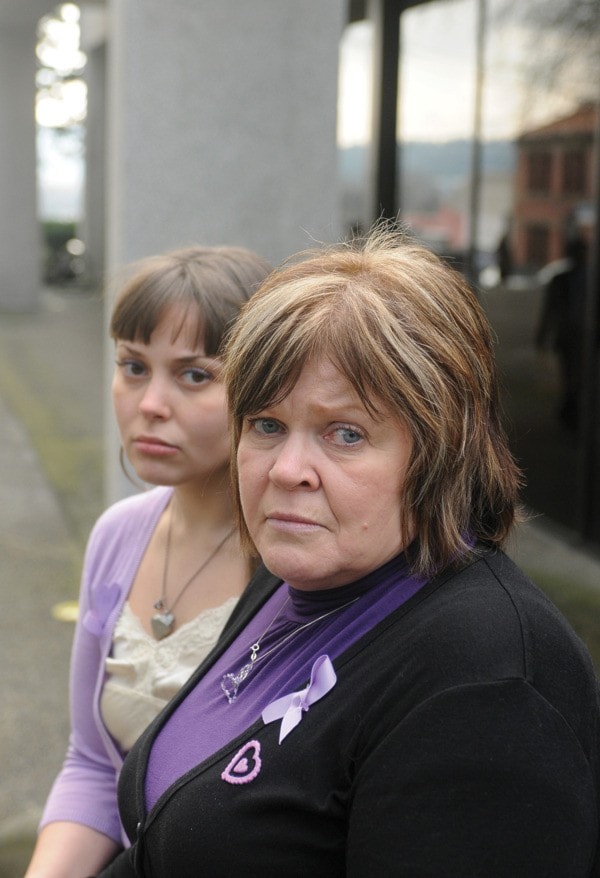A Maple Ridge teen was unresponsive hours before a woman charged in connection with her death called for an ambulance.
Ashley Dunn, a friend of Shannon Raymond, testified she heard her scream.
“It was probably the toughest day yet,” Julie Raymond, Shannon’s mother, said following Dunn’s testimony in court Thursday.
“Ashley testified that Shannon let out a blood-curdling scream and her screams continued for upwards of 25 minutes. It would give the appearance, from her body movements, that Shannon was in full seizure. How could anybody sit and watch that and not call 911? I can’t understand that. How could you do nothing?”
Victoria Turley made a 911 call at 6 a.m. on July 26, 2008, after finding 16-year-old Shannon unconscious in her former home on 119th Avenue in Maple Ridge.
Turley faces one count of failure to provide the necessities of life in connection with the death of Shannon – a charge laid under a rarely used section of the Canadian Criminal Code.
Police allege Shannon was in the care of the accused and was in medical distress, which Turley failed to address.
Crown prosecutor Jay Fogle said if Turley had called for an ambulance earlier, Shannon would likely have survived.
The summer that Shannon died was painted as a wild one in court this week during the trial.
Testimony from friends of the teen, who were with her on the night she died, revealed Shannon and her high school classmates were spending weekends getting drunk, usually keeping the binges secret from their parents.
Ashley Holding told the court Wednesday that she had spent the day with Shannon before they headed to a party for their friend Nicole on board a “party bus”.
Earlier that day, Shannon had expressed an interest in trying the drug ecstasy.
“She wanted to try it because all of us had and she hadn’t,” Holding, who was 15 at the time, told the court.
Shannon and her friends began drinking around 4 p.m. before heading to the celebration.
The court heard Shannon had a 26-ounce bottle of hard alcohol, which she was mixing with “Monster”, a highly caffeinated energy drink.
Holding gave Shannon the ecstasy pill on the party bus.
By the time Shannon and her friends arrived at Turley’s house, Shannon was staggering and need help walking into the backyard.
The court heard it was also Turley’s birthday that night and she was hosting a party.
At least five adults, who were at Turley’s party, checked on Shannon throughout the night, but none felt she needed medical attention.
Earlier in the week, Turley’s friend Richard Cassai testified he felt Shannon’s foot and hand to make sure she did not have a fever.
Another friend of Turley’s, Tammy McIver, believed that Shannon had a little too much to drink.
When McIver saw Shannon lying on the futon, where she eventually died, Shannon had a wet face-cloth on her forehead.
McIver told the court she told Shannon not to worry, that she’d feel better.
“She didn’t speak,” said McIver. “But acknowledged what I said with an ‘uhhuh’.”
Outside court, the family reacted to the testimony.
“It is really frustrating when we hear people, mostly from her peer group, characterizing her as a reckless kid who was out getting smashed all the time,” said Danielle Raymond, Shannon’s sister.
“That’s not what she was about. Our fear is that’s what people will hang on to when they hear about Shannon’s story. The issue is she was in medical distress and nobody helped her.”
The trial for Turley resumes next week.
Do You Know... Ecstasy
© 2003, 2010 CAMH
Street Name: E, XTC, Adam, the love drug
What is it?
The chemical name for ecstasy is 3,4-methylenedioxymethamphetamine, or MDMA. The chemical structure and the effects of MDMA are similar to amphetamine (a stimulant) and to mescaline (a hallucinogen).
What’s sold as ecstasy often contains drugs other than MDMA, which may or may not be similar in effect to MDMA. Some of the other drugs include caffeine, ephedrine, amphetamine, dextromethorphan, ketamine and LSD. Ecstasy sometimes contains highly toxic drugs, such as paramethoxyamphetamine (PMA), which can be lethal even in low doses. MDMA affects the chemistry of the brain, in particular by releasing a high level of serotonin. Serotonin is a chemical in the brain that plays an important role in regulating mood, energy level and appetite, among other things.
MDMA was patented in 1913 and has been used experimentally, most notably as a supplement to psychotherapy in the 1970s. It was made illegal to possess, traffic, import or produce MDMA in Canada in 1976 and in the United States in 1985.
Where does ecstasy come from?
Ecstasy is made in illegal labs with chemicals and processes that vary from lab to lab. What’s sold as ecstasy often contains unknown drugs or other fillers.
What does ecstasy look like?
Ecstasy is usually sold as a tablet or capsule that is swallowed. It may also be sold in powder form, or the tablets may be crushed and then snorted.
• We recommend that you do not use Ecstasy. Visit Ecstasy effects to learn why. If you are in the company of individuals using Ecstasy or are actually planning to use yourself, be aware of these safety precautions.
